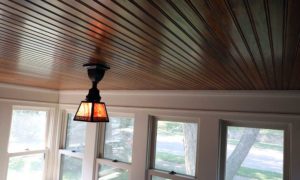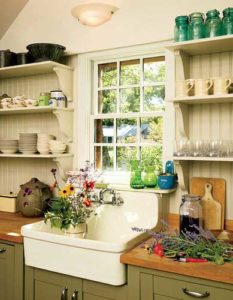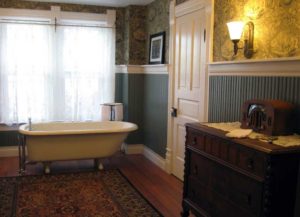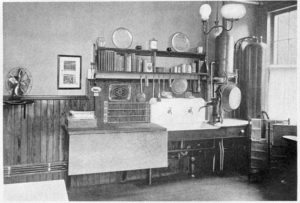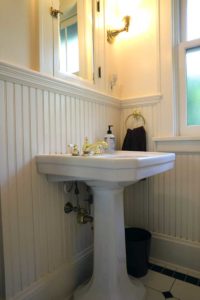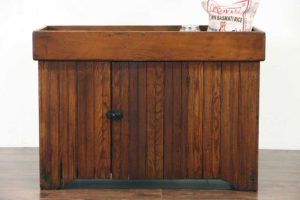Small Home Gazette, Summer 2021
Beadboard—Inexpensive and Versatile
I was working in the kitchen when I heard husband Marty excitedly yell for me to come see something. He had been removing acoustical tiles from the ceiling of our bungalow’s three-season front porch. The porch was our latest project, and we decided to start at the top to remove the remodeling done in the 1950s.
He had exposed an original-to-the house beadboard ceiling. It was lovely. Not a knot or joint to be seen in the wood.
What Is Beadboard?
Beadboard can be found in U.S. homes as early as the 1860s, becoming more common by 1880. The term “beadboard” refers to the earliest milled design consisting of two thin grooves with a small half-round, or “bead,” between them. This is the basic profile that was popular in Victorian times and is trendy today, often purchased in the form of sheet paneling.*
Early beadboard was made from scraps; was inexpensive; and was easy to install. Considered rustic, it was often used for kitchens, back halls, and other locations hidden from public view. Not meant to be a “public” material in a home, it continued to be used well into the 1930s and remained popular for use in stores; in summer homes and cottages; and in rural settings.
True beadboard is NOT sheets of paneling. Beadboard consists of tongue-and-groove planks that fit together snuggly just like floorboards; the only real difference is that each plank has milled designs cut into it that run lengthwise.
An older term for beadboard is car siding. Wooden railroad cars were lined with it because it withstood all the twisting and turning of the cars. It was also called “ceiling,” referring to its use on porch ceilings, and another name for it in New England was “sheathing.”
Early Uses
The biggest misconception about beadboard is that it was used mainly to cover walls (and sometimes room ceilings), but true beadboard, produced up to WWII, was used in many other ways. Beadboard was used everywhere in old houses from beadboard wainscoting** in bathrooms to beadboard ceilings on porches. There was really no place that it did not work well.
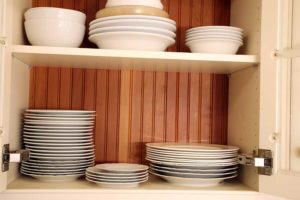 Beadboard’s interior uses included:
Beadboard’s interior uses included:
- the inside backs of cabinets;
- cabinet doors;
- inside bathroom medicine cabinets;
- inside closet walls and ceilings;
- attic hatches;
- walls and ceilings of utility rooms and secondary stairwells;
- and wainscoting. High-end homes would have wainscoting with raised panels but in everyday homes at the turn of the century, beadboard was the affordable choice.
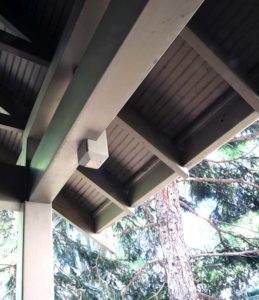 Beadboard’s exterior uses included:
Beadboard’s exterior uses included:
- porch ceilings (and sometimes porch floors, milled side down);
- garage door panels;
- accent siding;
- basement doors;
- and in soffits with exposed rafters.
Victorian vs. Craftsman
In addition to the bead-in-the-middle profile, Victorian beadboard was milled in various ornate styles. Some profiles added more repeats of the pattern while others offered different board widths.
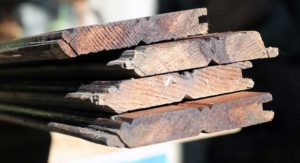
The end profile of reversible beadboard planks from a 1920 bungalow shows the beadboard-in-the-middle profile (top side) and v-groove profile (bottom).
In true Arts & Crafts fashion of reacting to overdone ornate Victorian style, beadboard of the Arts & Crafts era was often simplified to a v-groove down the middle of each board. The typical three-inch boards produced a pattern of a v-groove at every inch and a half. The back side of each board was usually smooth, but could be milled with the bead-in-the-middle profile. (It is not unusual to find one plank with a bead mistakenly mixed in with the v-groove planks on a bungalow porch ceiling.)
Beadboard was a material used on (and in) many bungalows—continuing the variety of uses from the Victorian era, except for limited use as wainscot.
What About Those Bathrooms (and Kitchens)?
In her book Bungalow Bathrooms, the late Jane Powell wrote, “As a rule the entire wall and ceiling was plastered, but often the ceiling and upper wall were plastered while the lower wall consisted of wooden wainscoting, either beadboard, board-and-batten, or ceramic.”
Beadboard’s construction made it a durable pick for bathrooms where there tends to be moisture lingering in the air. Powell continued: “Some authorities at the time felt that wooden wainscoting was not sanitary, but that did not stop many builders from installing it anyway.” And the use of ceramic tile was for those who had money.
In her companion book, Bungalow Kitchens, Powell used the same description for kitchen walls and ceilings as for bathrooms but added: “Occasionally the entire room was finished in beadboard, though this was more common in utility areas and porches. Usually the beadboard ran horizontally.”
The same features that made beadboard great for humid spaces also made it great for kitchens. It provided a tough surface, easier to clean (and more affordable) than plaster, and could take a few scuffs from chairs.
Using Beadboard in Your Bungalow Today
Several resources I found said beadboard was rarely used in bungalow bathrooms. If it was used, it was often in modest bungalows or in the family (less public) bathroom of more elaborate Arts & Crafts homes. Today, it is not unusual to walk into a bungalow and find a recently updated bathroom with Victorian-style reproduction beadboard wainscoting.
Following in Jane Powell’s footsteps of including “obsessive restoration” tips (as well as “compromise solution” tips) in her books, if you are planning to introduce beadboard in your bungalow, try to limit it to those areas and uses that would have been original to the era. And try to use planks rather than today’s sheet paneling. Also, for the more modest bungalow, the v-groove profile is authentic to the era—unless you have another original style to match.
Having said that, we have a mix of beadboard profiles in our bungalow. Our porch ceiling is bead-in-the-middle; the inside back of the bathroom medicine cabinet is v-board; and the doors on our basement storage cupboards are bead-in-the-middle with a v-board profile on the doors’ insides.
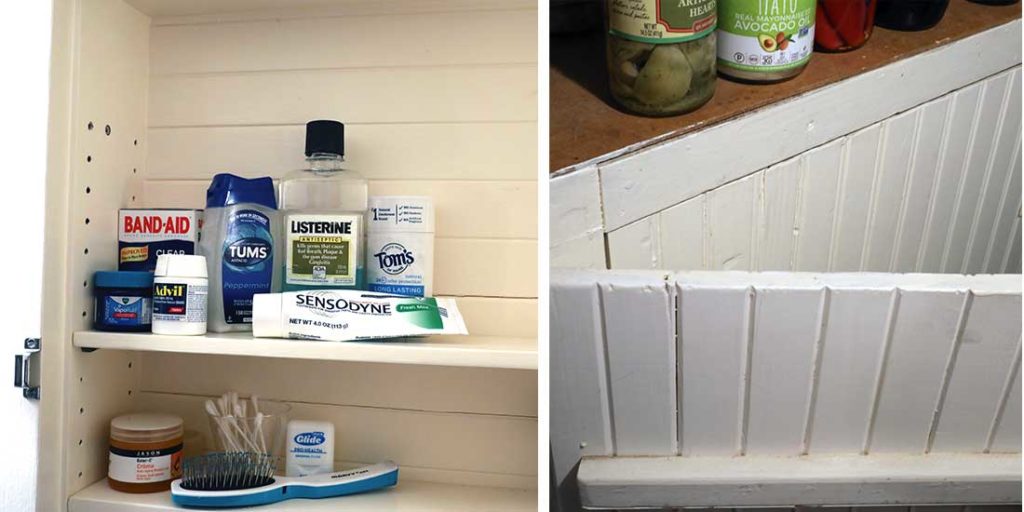
Left: V-groove beadboard was used for the back of the author’s bathroom medicine cabinet.
Right: Reversible beadboard planks were used for basement pantry doors. The bead-in-the-middle profile faces outward while v-groove is on the inside of the doors. Note the backing piece of wood used to stabilize the doors.
I like the look and versatility of beadboard in a room but it does work best in informal settings, often suggesting a cottage or rustic feel. I think I would follow Powell’s “compromise solution” tips and use beadboard thoughtfully. My dream is to have a mud room off the kitchen, with beadboard wainscoting. Beadboard was never meant to be a showcase material. Historically, beadboard was a basic, slightly decorative, affordable and durable finish.
Author’s Note: To really challenge your design sensibilities, I found this product on Amazon.com.
Graham & Brown Paintable Pre-pasted Beadboard Stripes Texture Wallpaper, White
56 sq ft for $25
Give your room a sense of character with a wainscoting appearance. This pre-pasted beadboard wallpaper gives the beautiful, streamline effect without all the work! Pre-pasted wallpaper for easy application. Pre-pasted paper already has adhesive on the back of the paper which is activated by dipping the wallpaper into a tray of water. It’s safe to use water and a mild detergent to clean. Beadboard wallpaper can be painted with a latex or oil-based semi-gloss paint to match any decor. Made in England.
*Paneling is a series of decorative wood panels covering walls from floor to ceiling.
**Wainscoting is a type of decorative paneling covering the lower three or four feet of walls. The two key elements of wainscoting are the frame and the panel. The frame has four pieces: the top and bottom rails and the two side pieces (or stiles). The type of panel used determines the name of the wainscoting—raised panel (or beveled), flat panel, board and batten, and finally, beadboard.









